Oklo stock tumbles as Financial Times scrutinizes valuation
Introduction & Market Context
Lazard Ltd (NYSE:LAZ) released its Q2 2025 investor presentation on July 24, 2025, highlighting improved financial performance compared to Q1 and outlining its ambitious "Lazard 2030" growth strategy. The global financial advisory and asset management firm reported total net revenue of $770 million for Q2 2025, representing a significant improvement from Q1 2025’s disappointing $648 million, though slightly below the $812 million achieved in the previous quarter.
The company’s stock has shown strong momentum, trading at $54.97 as of July 23, 2025, up 2.21% on the day and significantly higher than the $41.54 reported after Q1 earnings. This price appreciation suggests growing investor confidence in Lazard’s strategic direction despite earlier challenges.
Quarterly Performance Highlights
Lazard’s Q2 2025 performance shows signs of stabilization after a challenging first quarter. Total (EPA:TTEF) net revenue reached $770 million, with Financial Advisory contributing $491 million and Asset Management adding $287 million. While this represents a sequential decline from Q1’s $812 million, it marks a 12.4% improvement over the $685 million reported in Q2 2024.
As shown in the following quarterly performance chart, Lazard has experienced fluctuating revenue over the past five quarters, with Q1 2025 representing the high point during this period:

The company’s client base remains robust, with 99 Financial Advisory clients generating fees exceeding $1 million in Q2 2025, down from 115 in Q1 but significantly higher than the 79 reported in Q2 2024. Average Assets Under Management stood at $239 billion in Q2 2025, with average fees holding steady at 44 basis points.
Financial Advisory and Asset Management Segments
Lazard’s Financial Advisory segment generated $491 million in Q2 2025, representing approximately 64% of total revenue. This marks a substantial 20.3% increase from the $408 million reported in Q2 2024, reflecting stronger M&A activity and strategic advisory services. The segment’s performance has been bolstered by several high-profile transactions across various sectors.
The following chart illustrates the Financial Advisory segment’s performance over recent years, showing recovery from a challenging 2023:
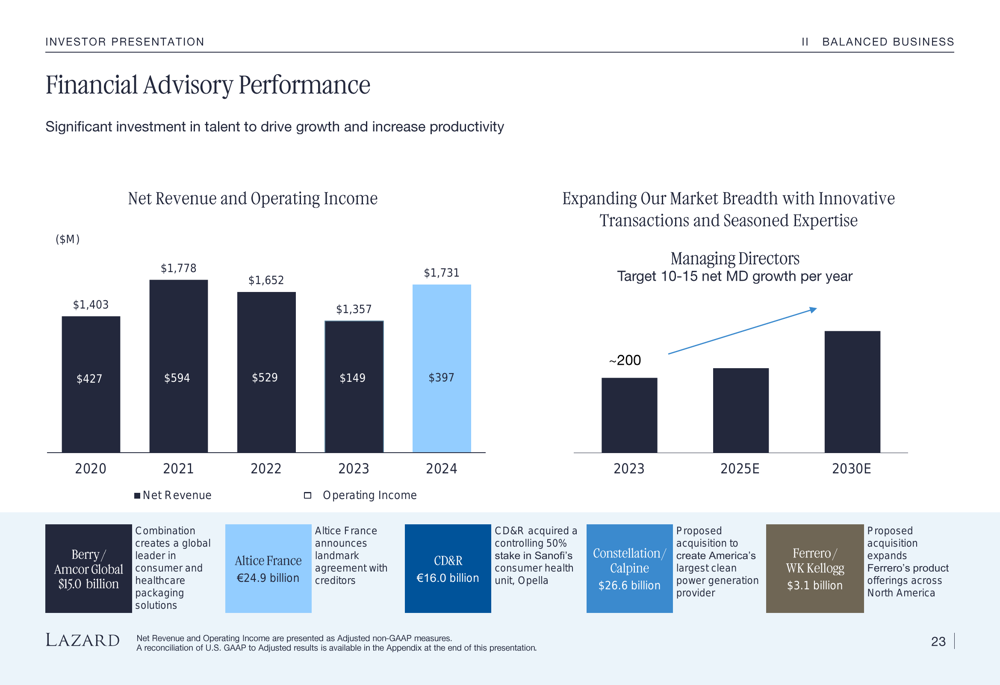
The Asset Management segment contributed $287 million in Q2 2025, up 8.3% from $265 million in Q2 2024. Assets Under Management reached $248 billion as of Q2 2025, with 63% of AUM in non-USD securities. The segment maintains a diversified portfolio across various asset classes, client types, and investment strategies.
As shown in the following chart, Lazard’s Asset Management assets are well-diversified:
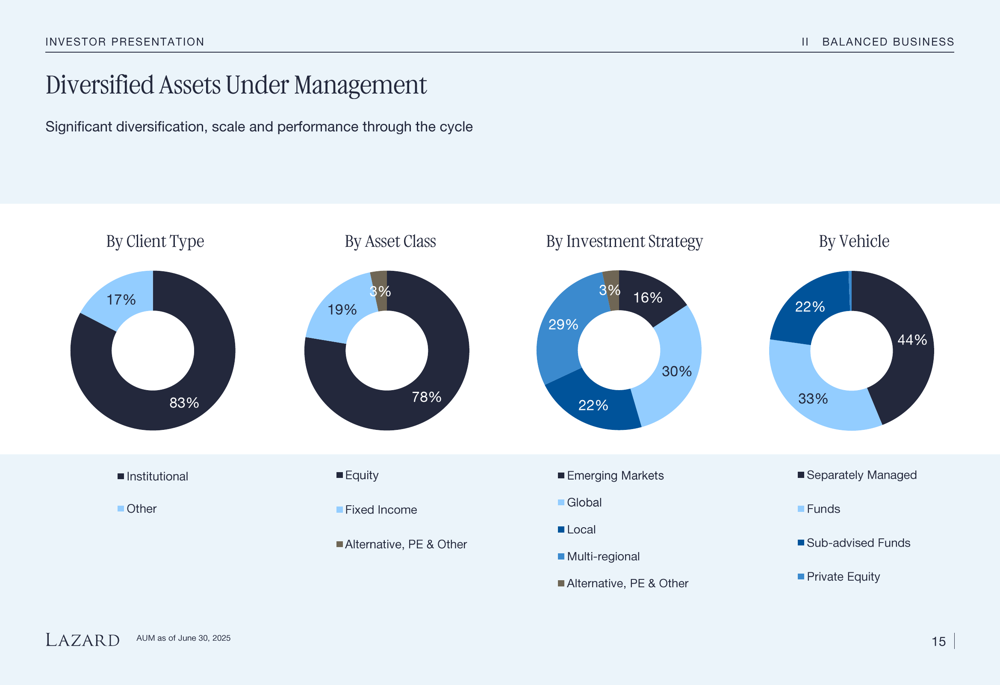
The Asset Management segment has faced margin pressure in recent years, with operating margins declining from 37% in 2020 to 24% in 2024, as illustrated in this profitability chart:
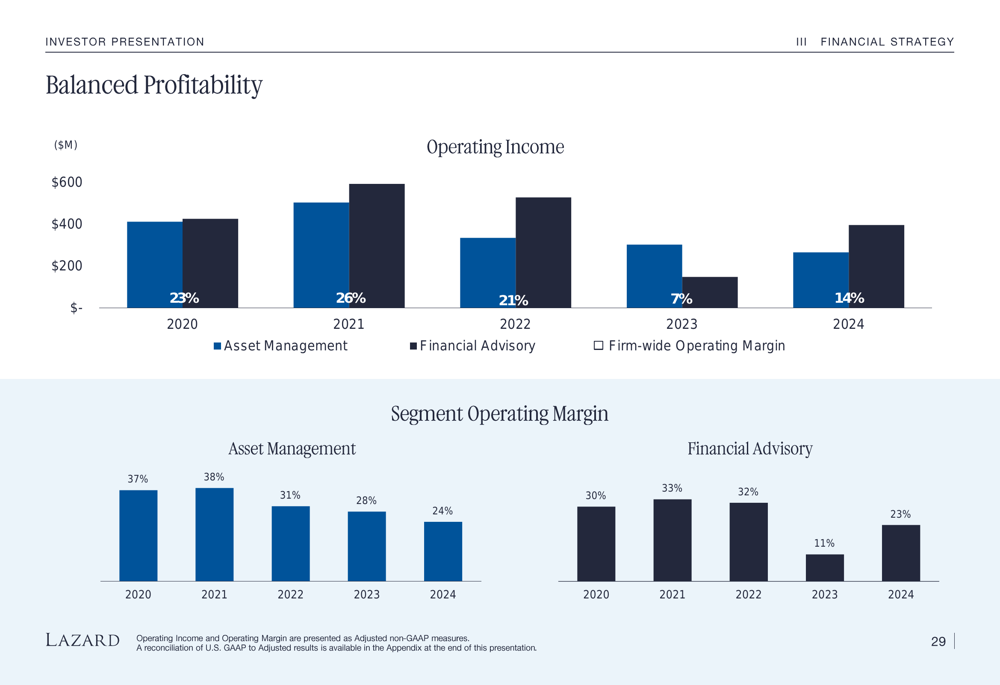
Strategic Initiatives and Growth Plans
Central to Lazard’s presentation is its "Lazard 2030" strategy, which aims to double revenue by 2030 while delivering 10-15% annual total shareholder returns. The plan focuses on recalibrating teams for growth, identifying market opportunities in key sectors, and establishing clear building blocks for success.
The strategy is outlined in the following slide:
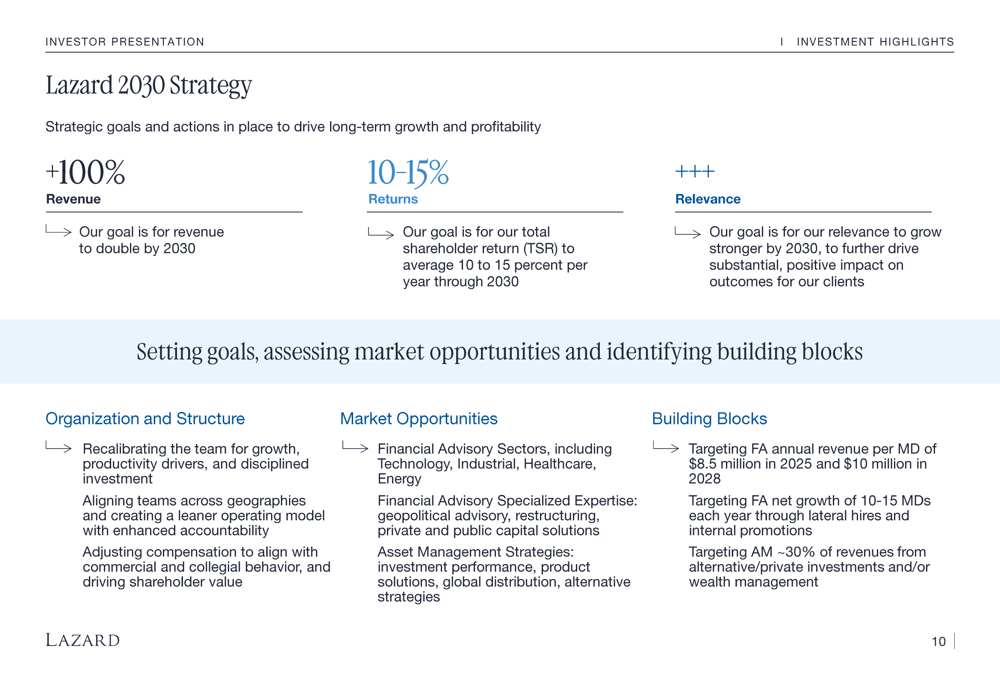
Lazard is also emphasizing technology integration, particularly artificial intelligence, to enhance operational performance. The company has developed proprietary tools like LazardGPT alongside vendor GenAI solutions to improve workflow connectivity, analytics, and client solutions.
As shown in the following technology strategy overview:
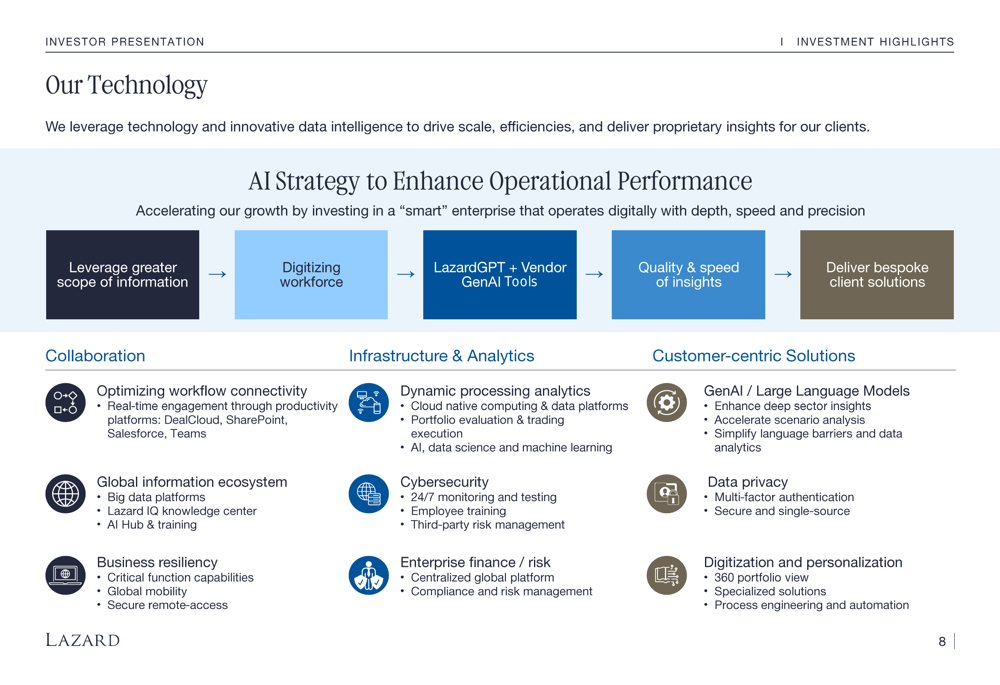
The firm is expanding its product offerings, particularly in the ETF space, with recently launched active U.S. ETFs including the Equity Megatrends ETF (THMZ), International Dynamic Equity ETF (IEQ), Japanese Equity ETF (JPY), and Next (LON:NXT) Gen Technologies ETF (TEKY). These initiatives represent new vectors of growth for the Asset Management segment.
Balance Sheet and Capital Management
Lazard maintains a strong balance sheet with $978 million in cash and cash equivalents as of Q2 2025. The company has $1.7 billion in senior notes with a weighted average coupon of approximately 4.7% and maintains investment grade ratings from all major credit agencies.
The following slide illustrates Lazard’s balanced debt profile with long-term maturities:
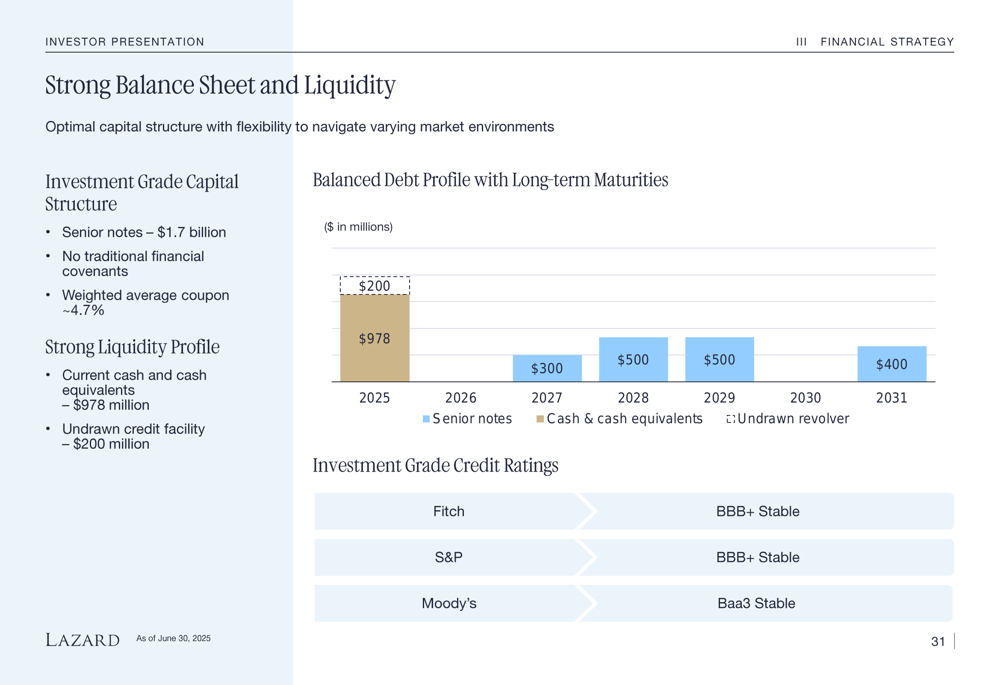
The company’s capital management strategy focuses on returning excess capital to shareholders while investing in growth. Lazard has maintained its quarterly dividend at $0.50 per share in 1H 2025, consistent with the $2.00 annual dividend paid in 2024. Share repurchases have decreased in recent periods, with weighted average shares outstanding increasing to 106.7 million in Q2 2025 from 104.4 million in 2024.
Forward-Looking Statements
Lazard’s presentation emphasizes expense discipline as a key priority, with target ratios of 60% or below for compensation expenses and 16-20% for non-compensation expenses. However, the company has struggled to meet these targets in recent years, with the compensation ratio reaching 65.9% in 2024.
As illustrated in the following expense discipline chart:
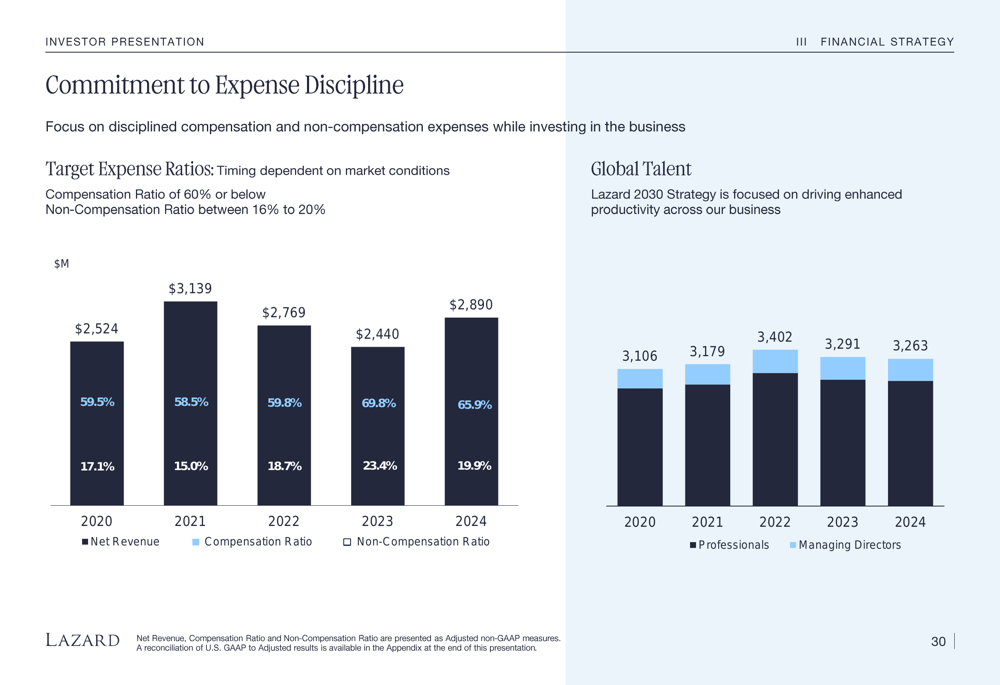
Looking ahead, Lazard is focused on several strategic growth catalysts, including energy transition, technology disruption, and healthcare evolution. The company sees significant opportunities in private capital markets, cross-border transactions, and geopolitical advisory services.
While the presentation paints an optimistic picture of Lazard’s future, it’s worth noting that Q1 2025 results fell short of expectations, with EPS of $0.56 compared to forecasts of $0.60. The company faces ongoing challenges including geopolitical uncertainties, competitive pressures in asset management, and potential shifts in investor allocations.
Nevertheless, the improved Q2 2025 performance suggests that Lazard’s strategic initiatives may be gaining traction, potentially positioning the company for more consistent growth as it works toward its ambitious 2030 goals.
Full presentation:
This article was generated with the support of AI and reviewed by an editor. For more information see our T&C.
